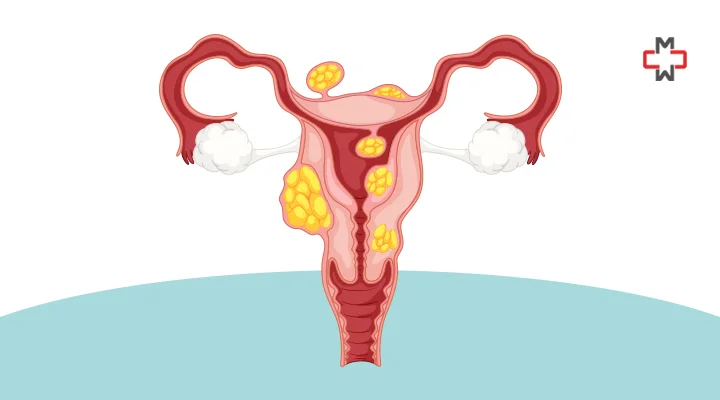Short Answer: Fibroids larger than 5–10 cm (2–3.9 inches) are generally considered more dangerous, especially if they cause symptoms like heavy bleeding, pelvic pressure, infertility, or pressure on surrounding organs.
Understanding Fibroids
Fibroids, also known as uterine fibroids, are non-cancerous tumors that grow in the uterine wall. While they are common and often harmless, their size, number, and location can impact overall health, fertility, and quality of life. Uterine fibroids affect millions of women in the U.S. and are one of the leading causes of gynecological visits.
Women develop uterine fibroids mostly during reproductive age, and fibroids tend to grow under the influence of hormonal factors, lifestyle factors, and genetic factors.
Fibroids can be categorized based on location:
- Intramural fibroids: Within the muscular uterine wall
- Submucosal fibroids: Just beneath the uterine lining, protruding into the uterine cavity
- Subserosal fibroids: On the outer wall of the uterus
- Pedunculated fibroids: Attached to the uterus by a stalk-like structure
Routine checkups often help detect uterine fibroids early, especially when symptoms are mild or unnoticeable.
Fibroid Size Categories
Fibroid size plays a major role in determining symptom severity and the need for medical intervention. Below is a general breakdown:
| Category | Size Range (cm) | Size Range (mm) | Common Terms |
|---|---|---|---|
| Small fibroids | 1–5 cm | 10–50 mm | Size of a seed to cherry |
| Medium fibroids | 5–10 cm | 50–100 mm | Plum to orange |
| Large fibroids | >10 cm | >100 mm | Grapefruit to watermelon |
Which Size of Fibroid is Dangerous?
A fibroid is dangerous when it causes severe symptoms, interferes with organs, or impacts fertility. While there’s no exact size that automatically makes a fibroid harmful, the size of fibroids combined with their location increases risks.
Many patients ask, “Which size of fibroid is dangerous?” This question is key to early intervention. Doctors typically evaluate both fibroid size and symptom presentation to determine treatment.
Danger thresholds:
- >5 cm fibroids: May start to affect the uterine cavity, distort the uterine lining, and cause heavy menstrual bleeding or fibroid-related pain
- >10 cm fibroids: Considered large fibroids, commonly cause frequent urination, pelvic pain, pelvic pressure, or weight gain
- >12 cm fibroids: May need surgical removal due to impact on surrounding organs
Clinically, physicians use size benchmarks when determining which size of fibroid is dangerous, but location and impact on fertility carry equal weight.
If left unchecked, rapid growth or giant fibroids can cause blood clots, severe pain, and even pregnancy complications. That’s why understanding which size of fibroid is dangerous can make a difference in long-term reproductive health.
Symptoms by Fibroid Size
Small Fibroids (1–5 cm):
- Often cause mild symptoms or no symptoms at all
- If located submucosally, may still cause heavy bleeding or affect implantation
Medium Fibroids (5–10 cm):
- Can cause heavy menstrual bleeding, pelvic pressure, and noticeable symptoms
- Can contribute to infertility or pregnancy complications
Large Fibroids (>10 cm):
- Commonly cause significant pelvic pain, weight gain, and compression of surrounding organs
- May result in bladder pressure, constipation, or back pain
- Often require surgery or minimally invasive treatments like uterine fibroid embolization
What Fibroids Can Cause
Fibroids can cause a wide range of associated symptoms:
- Heavy menstrual bleeding
- Severe pelvic pain or pelvic pressure
- Frequent urination
- Constipation
- Back pain
- Heavy vaginal bleeding
- Fibroid-related pain during intercourse or physical activity
- Anemia from prolonged bleeding
- Pregnancy complications such as miscarriage or preterm labor
The severity of fibroid symptoms doesn’t always correlate with size. Even small fibroids in sensitive areas can trigger significant symptoms.
Because uterine fibroids vary in how they present, even two women with similar fibroid sizes might report drastically different symptoms.
Factors That Influence Fibroid Growth
Several risk factors and conditions influence fibroid growth and fibroid size, including:
- Hormonal factors: Estrogen and progesterone promote growth
- Genetic factors: Family history increases likelihood
- Lifestyle factors: Obesity, stress, diet, and low Vitamin D levels
Additionally, research suggests that blood flow to the uterus and uterine health also affects fibroid size. Medical experts agree that ongoing inflammation may also affects fibroid size over time.
Environmental exposure to endocrine disruptors and diet quality are also known areas where fibroids influence women’s reproductive health. Similarly, stress hormones and metabolic imbalance fibroids influence how fast they develop or worsen.
More recent studies on uterine fibroids also point to inflammation, BMI, and insulin resistance as factors that fibroids influence, leading to unpredictable growth patterns.
Monitoring for fibroids tends to be more common in women who attend regular gynecological checkups. Detecting growth early helps avoid further complications.
Fibroid Treatment & Surgical Options
The best fibroid treatment depends on fibroid size, symptom severity, and reproductive plans. Treatment options include:
Minimally Invasive Treatments
- Uterine fibroid embolization (UFE): Blocks blood flow to fibroid tissue by targeting the uterine artery, causing shrinkage
- MRI-guided focused ultrasound (HIFU): Uses heat to destroy fibroid tissue
Surgical Interventions
- Myomectomy (laparoscopic or open): Removes fibroids while preserving the uterus
- Hysterectomy: Full removal of uterus, used for very large fibroids or when severe symptoms are not manageable
- Fibroid surgery is often required when fibroids reach sizes impacting uterine tissue or the uterine lining. In such cases, discussing treatment options with a specialist is essential to determine the safest path forward.
For some women, fibroid surgery may be the only viable route when non-surgical methods are not effective. Choosing among available treatment options ensures that care is tailored to the patient’s symptoms, goals, and health status.
Incorporating personalized strategies to manage uterine fibroids can reduce recurrence and minimize the need for future intervention.
When to Seek Medical Help
Talk to a doctor if you notice:
- Heavy menstrual bleeding lasting more than 7 days
- Pelvic pain that interferes with daily life
- Frequent urination or digestive issues
- Enlarged abdomen or sudden weight gain
- Trouble conceiving
Our primary care physician, Dr. Syra Hanif, has helped many women manage fibroids with both non-surgical and surgical methods, tailored to their needs.
🔹 Book a Walk-In or Online Appointment
FAQs
What size fibroids need surgery?
Fibroids that are larger than 5–6 cm or causing severe symptoms often need surgical removal, especially if fertility is a concern.
Can a 5 cm fibroid cause pain?
Yes. A 5 cm fibroid, particularly if located near the uterine lining or uterine cavity, can cause pelvic pressure, heavy bleeding, and fibroid-related pain.
Which type of fibroid is not dangerous?
Subserosal fibroids that are small and grow outward tend to be less harmful unless they grow large enough to press on surrounding organs.
What happens if fibroids are not removed?
They may continue growing, causing further complications like anemia, urinary problems, or pregnancy complications.
Final Thoughts
Fibroids are non-cancerous tumors, but that doesn’t mean they’re always harmless. The danger of a fibroid depends on its size, location, fibroid growth, and symptom severity. At Manhattan Medical Arts, we help patients manage all types of uterine fibroids—from small fibroids with mild symptoms to large fibroids that require advanced care.
If you’re still asking, “Which size of fibroid is dangerous?”—the answer depends on more than dimensions. Clinical monitoring and imaging help determine the best course of action.
🔹 Schedule a Virtual Consultation with Dr. Syra Hanif
– Disclaimer –
This blog is for informational & educational purposes only and does not intend to substitute any professional medical advice or consultation. For any health-related concerns, please consult with your physician, or call 911.
-
About The Author
Dr. Syra Hanif M.D.Board Certified Primary Care Physician
Dr. Syra Hanif is a board-certified Primary Care Physician (PCP) dedicated to providing compassionate, patient-centered healthcare.
Read More







